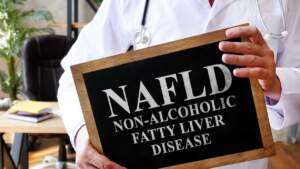Fatty liver disease, also known as hepatic steatosis, is a condition characterized by the accumulation of excess fat in the liver. Excessive fat accumulation (steatosis) in the liver (> 5%of hepatocytes histologically). This buildup of fat can impair liver function and lead to various complications if left untreated.
Table of Contents
ToggleExploring the Varieties of Fatty Liver Disease: The main categories of fatty liver disease include
Non Alcoholic Fatty Liver Disease (NAFLD)
- This represents the prevalent type of fatty liver disease.
- It is often associated with obesity, insulin resistance, metabolic syndrome, and other risk factors.
- NAFLD can range from simple fatty liver (steatosis) to non-alcoholic steatohepatitis (NASH), which involves inflammation and liver cell damage. NASH has the potential to progress to cirrhosis and liver failure.
Alcoholic Fatty Liver Disease (AFLD)
- AFLD occurs due to excessive alcohol consumption over an extended period.
- It can progress from alcoholic fatty liver (steatosis) to more severe conditions like alcoholic hepatitis and alcoholic cirrhosis if alcohol abuse continues.
Risk Factors for NAFLD : Common risk factors for fatty liver disease include:
- Obesity
- Type 2 diabetes or insulin resistance
- Metabolic syndrome
- High cholesterol or triglycerides
- Certain medications
- Poor diet
- Sedentary lifestyle
- Hypothyroidism
- Sleep apnea
- Polycystic ovarian Syndrome or (PCOS)
Non Alcoholic Fatty Liver Disease Symptoms

Fatty liver disease is often asymptomatic in its early stages. Symptoms begin to get noticed once liver disease progresses, these can include: loss of appetite, fatigue, jaundice, confusion or encephalopathy, bleeding with minor trauma.
Non Alcoholic Fatty Liver Disease Diagnosis
- Blood Tests: Liver function tests showing elevated alanine aminotransferase (ALT) >30 in males and >20 in females and elevated aspartate aminotransferase (AST) normal range <30)
- Imaging: Ultrasound, CT scans, or MRI can detect the presence of fatty liver and assess its severity.
Liver Biopsy: In some cases, a liver biopsy may be recommended to confirm the diagnosis and determine the extent of liver damage. - Treatment and Management: Treatment and management of fatty liver disease primarily involve addressing the underlying causes and risk factors:
- Lifestyle Modifications: Lifestyle changes are often the first line of treatment.
Weight loss through a balanced diet and regular exercise is crucial. Reducing as little as 10 percent of the current weight can reverse fibrosis.
Reducing or eliminating alcohol consumption is essential for AFLD.
Managing underlying conditions like diabetes and high blood pressure. - Medications: In some cases, medications may be prescribed to manage specific aspects of the disease, such as diabetes, high cholesterol, or metabolic syndrome.
Regular Monitoring: Patients with fatty liver disease should have regular follow-up appointments to monitor their liver function, assess progress, and adjust treatment as necessary. - Prognosis: The prognosis for fatty liver disease depends on various factors, including the underlying cause, disease severity, and how well the patient responds to treatment. Early detection and lifestyle modifications can often prevent or reverse liver damage in many cases. However, if left untreated or in advanced stages, fatty liver disease can lead to more severe liver conditions, including cirrhosis and liver failure.


